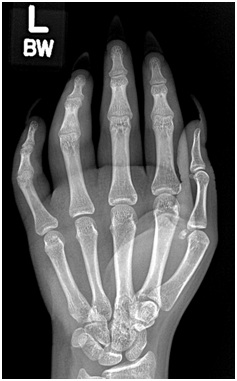
Polyarthritis in a 14 Years Old Girl- A Case Report
*Corresponding Author(s):
Lin Lin KinDepartment Of Pediatrics, Bronx Care Health System, Bronx, New York, United States
Abstract
A variety of conditions can present as polyarthritis. Migratory polyarthritis is well-known for Acute Rheumatic Fever (ARF) especially in children, most commonly between 5 – 15 years of age. Other clinical conditions can present as migratory polyarthritis also. We present a 14-year old girl with migratory polyarthritis involving both large and small joints.
Keywords
Polyarthritis; Post infectious arthritis
CASE REPORT
History of present illness
A 14-year old girl presents with 3-day history of bilateral hand swelling and pain.Pain and swelling initially began in her right ankle, later shifted to the right knee and then involved her right shoulder. The following day, she developed redness and swelling of her left ring finger which progressively increased in size (Figure 1). There was significant history of sore throat a week prior to onset of symptoms which was left untreated.
Patient denied history of trauma, bites, skin rash, fever, chills, abdominal pain, diarrhea, change in urinary color or output. No history of food or drug allergies, similar symptoms in the past or recent travel. Her Last menstrual period was 2 weeks prior to presentation. Significant family hx of rheumatoid arthritis in maternal Grandmother. She rears 2 cats, a dog, a hamster and a fish. Denies drinking alcohol or smoking cigarettes. Sexually active with a male partner but no history of sexually transmitted infections.
 Figure 1: Soft tissue swelling of the left 4th finger.
Figure 1: Soft tissue swelling of the left 4th finger.
Physical findings on arrival and initial management approach
Patient appeared fatigued but not in obvious painful distress. Hand examination was remarkable for swelling and erythema over the left ring and middle proximal interphalangeal joints with restriction of active and passive range of motion. Neurovascular status remained intact. There were no skin rash, cardiac murmurs or swellings in other areas.
Vital signs: Temperature of 99.6 F, HR 102/min, RR 16/min, BP 128/84 - 99/48 mmHg.
Orthopedic consultation yielded suspicion of cellulitis. IV antibiotics, analgesia and placement of left volar splint with recommendation to see a rheumatologist based on negative radiological findings given. On follow up with the rheumatologist six days after the onset of illness, there was complete resolution of the symptoms. Differential diagnosis broadened to include; Post-streptococcal arthritis, Acute Rheumatic Fever, Juvenile rheumatoid arthritis, Spondyloarthropathies, Post-infectious reactive arthritis, Septic arthritis, Crystal arthropathy, Post-viral arthritis, Whipple’s disease and Systemic Lupus Erythematosus.
Pertinent laboratory and imaging results
|
Hand X -ray: No fracture or dislocation but remarkable for soft tissue swelling. |
|
White blood cell count (WBC): -10,800 (4.5 -12.0 k/µl) |
|
Erythrocyte Sedimentation Rate (ESR): - 54.0 (0- 30 mm/hr) |
|
C-reactive protein (CRP): - 68.06 (< 5 mg/dl) |
|
Complements C3: - 207.0 (90-150 mg/dl) |
|
Complement C4: - 38.0 (16.0-47.0 mg/dl) |
|
Rheumatoid factor 14.4 (< 14.0 IU/ml) |
|
Anti-deoxyribonuclease B (DNase B): -321 ( |
|
Anti-Streptolysin O antibodies: - 931 ( |
|
Nucleic Acid Amplification Testing (urine): - Positive for Neisseria gonorrhea |
|
Electrocardiogram: - Normal Sinus rhythm. No evidence of prolonged PR interval. |
|
(Reference range in parenthesis) |
Diagnosis: Post Infectious Arthritis mimicking Acute Rheumatic Fever (ARF) (A rare case of Co-occurrence of post-streptococcal reactive arthritis and acute gonococcal arthritis).
DISCUSSION
Acute Rheumatic Fever (ARF), Post Streptococcal Reactive Arthritis (PSRA) and Gonococcal arthritis in adults can present in a similar manner. However, in the pediatric population, there tends to be distinct differences among them. Distinction varies from the duration in onset of symptoms to the types of joints affected. In Sexually active adolescents and younger adults, Neisseria gonorrhoeae is the most common cause of infectious arthritis. Whereas, PSRA is more common in pre-school and school aged children. Migratory arthritis is characterized by rapid onset of swelling in one or two joints, with resolution over a few days. As the symptoms resolve, similar symptoms emerge in another joint, usually in an asymmetric location. This symptom pattern can occur in gonococcal arthritis, rheumatic fever, sarcoidosis, systemic lupus erythematosus, Lyme disease, bacterial endocarditis, and Whipple’s disease [1]. PSRA which was first described in 1982 usually involves the large joints but may involve small peripheral joints also, does not respond to acetylsalicylic acid, occurs approximately 10 days following upper respiratory tract infection with group A beta-hemolytic streptococcus and other signs of ARF are absent [2,3]. They lasted longer or recurrent for approximately 2 months compared to ARF arthritis which lasts 1 -5 days with complete resolution by 3 weeks. PSRA and gonococcal arthritis are two separate entities and rarely exist together but there can be an overlap in their presentation in such a way that one looks similar to the other in the absence of a known etiology. Our patient’s scenario is one that combines the two entities, also mimicking ARF before the etiologies were diagnosed. The presence of migratory poly arthralgia and mono-articular arthritis seen in our patient is an overlapping feature of both diseases.
There is a paucity of recent epidemiologic data that looks into the incidence of arthritis in patients with gonorrhea, but historical data in the 1980s show that N. gonorrhoeae were associated with up to 14% of patients who have arthritis.
The patient presents with additive arthritis with clinical and serological evidence of a prior streptococcal infection and acute gonococcal infection but does not fulfill the Jones criteria with must include two major (migratory polyarthritis, carditis, chorea, erythema marginatum, and subcutaneous nodules) or one major and two minor features (arthralgia, fever, elevated erythrocyte sedimentation rate, elevated C-reactive protein, or a prolonged PR interval)with evidence of preceding group A streptococcal infection [4]. Our patient had only one major (arthritis) and one minor criteria(elevated acute phase reactant) and elevated ASLO titer which was insufficient to make a diagnosis of ARF. The presence of elevated ASLO titer and positive NAAT for Gonorrhea [5] were the reason the clear-cut differentiation in the etiology were made. The patient was subsequently treated with 1gm of IV Ceftriaxone and was also discharged home on Amoxicillin.
CONCLUSION
Identifying the cause of polyarticular joint pain can be difficult because of the extensive differential diagnosis. A thorough history and a complete physical examination are essential. Six clinical factors are helpful in narrowing the possible causes: disease chronology, inflammation, distribution, extra-articular manifestations, disease course, and patient demographics. Hence, it is imperative to have a high index of suspicion in all adolescents and young adults presenting with arthritis as the cause could cut across several disease entities.
In line with the AHA recommendations, the patient should be evaluated for signs of carditis clinically and by echocardiogram and treated with prophylactic antibiotic for a year. After a year of treatment, she should be evaluated again for signs of carditis. If carditis is not observed antibiotic prophylaxis should be discontinued [6].
REFERENCES
- Mies Richie A, Francis ML (2003) A diagnostic approach to polyarticular pain. Am Fam Physician 68: 1151-1160.
- The Canadian journal of infectious disease, 1995 May-Jun; 6: 133-135.
- Nelson Textbook of pediatrics 20th Edition, 183, Pg no. 1331.
- Grover V, Dibner R (2009) Polyarthritis following a streptococcal infection, a doctor's dilemma in treatment: A case report. Cases J 2: 9140.
- Papp JR, Schachter J, Gaydos CA, Van Der Pol B (2014) Morbidity and Mortality Weekly Report (MMWR): Recommendations for the Laboratory-Based Detection of Chlamydia trachomatis and Neisseria gonorrhoeae. 2014: 1-19.
- Uziel Y, Perl L, Barash J, Hashkes PJ (2011) Post streptococcal reactive arthritis in children, A distinct entity from Acute rheumatic fever. Pediatr Rheumatol Online J 9: 32.
Citation: Kin LL, Adeniyi M, Asfaw M (2019) Polyarthritis in a 14 Years Old Girl- A Case Report. Int J Case Rep Ther Stud 1: 005.
Copyright: © 2019 Lin Lin Kin, et al. This is an open-access article distributed under the terms of the Creative Commons Attribution License, which permits unrestricted use, distribution, and reproduction in any medium, provided the original author and source are credited.

